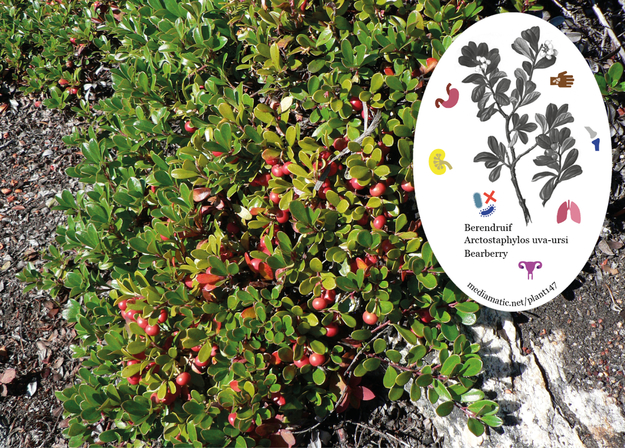Bearberry was commonly used by many native North American Indian tribes to treat a wide range of complaints and has also been used in conventional herbal medicine for hundreds of years, it is one of the best natural urinary antiseptics. The leaves contain hydroquinones and are strongly antibacterial, especially against certain organisms associated with urinary infections. The plant should be used with caution, however, because hydroquinones are also toxic. The leaves are antiseptic, astringent, diuretic, lithontripic, hypnotic and tonic. The dried leaves are used in the treatment of a variety of complaints These leaves should be harvested in early autumn, only green leaves being selected, and then dried in gentle heat. A tea made from the dried leaves is much used for kidney and bladder complaints and inflammations of the urinary tract such as acute and chronic cystitis and urethritis, but it should be used with caution and preferably only under the supervision of a qualified practitioner. The tea is more effective if the urine is alkaline, thus it is best used in combination with a vegetable-based diet. Externally, a poultice of the infused leaves with oil has been used as a salve to treat rashes, skin sores etc, and as a wash for a baby's head. An infusion of the leaves has been used as an eyewash, a mouthwash for cankers and sore gums and as a poultice for back pains, rheumatism, burns etc. The dried leaves have been used for smoking as an alternative to tobacco. One report says that it is unclear whether this was for medicinal purposes or for the intoxicated state it could produce, whilst another says that the leaves were smoked to treat headaches and also as a narcotic. The herb should not be prescribed to children, pregnant women or patients with kidney disease. Another report says that some native North American Indian tribes used an infusion of the stems, combined with blueberry stems (Vaccinium spp) to prevent miscarriage without causing harm to the baby, and to speed a woman's recovery after the birth. Other uses: fluid retention and bed wetting. Claimed to strengthen the heart muscle and urinary tract and to return the womb to its normal size after childbirth. Treatment should be short (seven days) and used with an alkaline diet. Not recommended for children under 12. Source: https://pfaf.org/
Bearberry
Arctostaphylos uva-ursi
Find more about this plant on Wikipedia.

Bearberry - Arctostaphylos uva-ursi Bearthierry | Author: Walter Siegmund